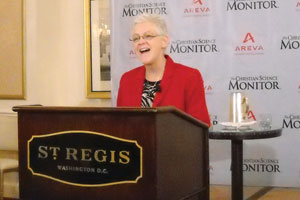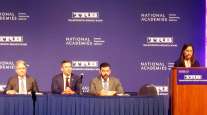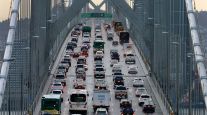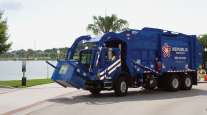Efforts to Cut Greenhouse Gases Must Ramp Up, McCarthy Says

This story appears in the July 13 print edition of Transport Topics.
WASHINGTON — The Environmental Protection Agency will continue to emphasize the Obama administration’s campaign against climate change from carbon emissions, even if all aspects of useful technologies are not known at present.
Speaking July 7 at a press event here, EPA Administrator Gina McCarthy said reducing carbon dioxide and other greenhouse-gas emissions is so important an issue that government action cannot wait until everything is known about it.
“We have to get started,” said McCarthy, the EPA chief since 2013, adding that her agency must focus on the issue now.
Failure to act, she said, would be “shortsighted and disappointing.”
She said during the one-hour event sponsored by The Christian Science Monitor: “We can save billions of dollars and many lives if we act now. We will lose billions and human lives if we fail to act.”
McCarthy reminded reporters and editors that trucking is part of the regulatory schedule. On June 19, EPA and the National Highway Traffic Safety Administration unveiled Phase 2 of their regulations on heavy- and medium-duty truck emissions for greenhouse gases.
A final version of the Phase 2 proposal is expected next spring.
In addition to large trucks, McCarthy said, EPA is regulating cars and light vehicles, aircraft and power plants. The administration also is working on bilateral agreements with other nations and a large-scale summit among many nations in Paris at the end of this year.
She said EPA is “not a one-trick pony” and that staff looks at pollution output across various sources.
While McCarthy admitted to some disagreements with Republicans in Congress, she claimed Pope Francis as an ally, based on his recent encyclical on climate change and its effects on people.
“It’s a game changer,” McCarthy said of the papal document published June 18. “He can reach more people than we can,” she said, adding that Francis’ statement was both “hopeful” about the future and interesting, in that he stressed climate change would hit the poor severely because they don’t have the resources to get out of its way.
Restricting greenhouse-gas emissions should not be considered a drain on the economy, she said, offering a two-part argument. Concerning agriculture and fishing, lessening the effects of change helps preserve jobs connected to those industries where they currently exist. McCarthy noted that certain fish are attracted to areas of cold water.
In terms of manufacturing, McCarthy reiterated comments from President Obama that the development and production of emissions-reduction technologies should be a natural fit for U.S. companies. She said many countries currently have better systems, but the United States can catch up with investment.
“We shouldn’t be ceding this technology to others,” McCarthy said. “Developing these systems is fundamental to growing our economy, and we can win. There is no country better at this than we are.”
Developing emissions-control devices could lead to international sales, she said, because lowering carbon requires broad participation by many countries.
EPA has taken a mixed ap-proach to specifying technologies. Sometimes, the agency lists a numerical standard on emissions and lets manufacturers determine how to proceed.
That was the case with exhaust-gas recirculation and selective catalytic reduction. It was repeated with technologies developed in the SuperTruck research and development program to improve mileage.
In contrast, EPA’s trailer regulation in the Phase 2 proposal may make many of the agency’s voluntary SmartWay suggestions mandatory, starting in 2018. The SmartWay program helps the freight transportation sector reduce emissions.
Glen Kedzie, environmental and energy affairs counsel for American Trucking Associations, said technology-forcing requirements can be troublesome.
“Testing by manufacturers is one thing, but what about fleets? We’re the most important stage because fleets actually use the trucks,” Kedzie said.
He said extensive on-road testing is important because different fleets use trucks for a wide array of applications over particular routes.
“You really don’t know if something will work until you try it yourself,” Kedzie said.




